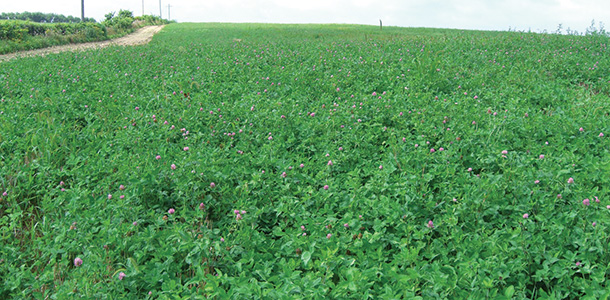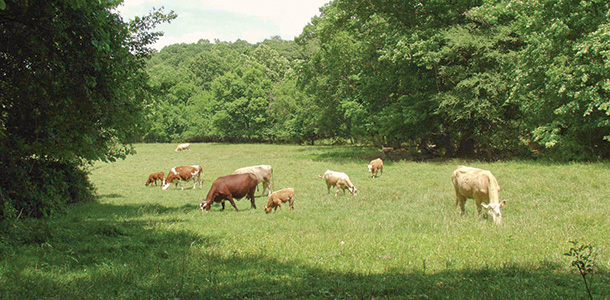Grass is a key component in any grazing enterprise.
Cow-calf and stocker are the most common classes of cattle for a forage system that keeps cattle on the move grazing as many days as possible.
Forage species in some regions of the country look green and lush, but they are actually profit robbers when not managed correctly.
“With continuous grazing, fescue toxicity is devastating to gains on stocker cattle. Milk production and fertility drop drastically for cow-calf operations, costing the industry millions,” says Dr. Craig Roberts, a forage specialist with the University of Missouri.
“Producers have to know their pastures to adequately manage endophyte-infected fields.
Infected fescue is the dominant grass in some pastures, which makes it really stressful for lactating cows to breed back at certain times,” says Dr. Keith Johnson, a Purdue University forage crops specialist.
For some regions of the country, common tall fescue or Kentucky 31, as some refer to it, is a necessary evil.
The hardy plants will flourish on ground where not much else will grow. The toxins produced can be harmful to the very animals that depend on the grass for daily nutrient supply.
“With infected fescue pastures, you have to manage maturity and know enough about your pastures to get the cows grazing the right pastures at the right time of year,” Johnson says.
“There are other grasses and novel endophyte varieties that aren’t toxic, but not every acre of infected fescue needs to be replaced. It’s expensive, and for acreage that has erosive soils, it would be a high-risk transition.”
“The toxins are there at any time during the year. These toxins peak in late May and early October, but they are always present,” Roberts says. “It looks like the forage quality is great, but the toxins override what the forage seems to be.”
Diluting the endophyte consumed by cattle was an early answer in the beef business as cattlemen were still trying to figure out what they were dealing with in the grass.
Common sense told cattlemen legumes were a good option because grazing was sparse once the cool-season grass went dormant during the months some of these species would thrive.
“Even before we knew about endophyte, incorporating legumes into the forage improved reproductive efficiency and calf gain.
Legumes are a great complement to any cool-season grass such as orchardgrass or the novel endophyte fescue varieties because they add to forage diversity and reduce nitrogen requirements,” Johnson says.

“Red and white clover are some of the most common legumes to add to tall fescue stands. If the tall fescue is really aggressive, it may be hard to establish stands of other grasses.
The goal is to have cows grazing where each mouthful contains more of something else than infected fescue at critical times like breedback.”
“Old tall fescue varieties lead to higher input costs because you have to effectively manage the grass,” Roberts says. “Incorporating clover or feeding something like soyhulls just adds to cost.”
The harmful toxins brought many answers, and like a lot of things, it takes a “trial run” to get it right.
Nobody ever wants the first pickup with the new engine or that computer that changes into a new batch of programs because most think they are asking for problems.
Much the same can be said with producers jumping on board with endophyte-free varieties, which eventually evolved into novel endophyte fescue grass.
“I was never sold on the endophyte-free varieties. They just didn’t work in Missouri,” Roberts says. “The common varieties still produce the toxin, while the novel endophyte varieties have a non-toxic endophyte.
The main difference between the new varieties and the old Kentucky 31 is how you graze them. You have to take care of the novel endophyte varieties because if you overgraze, you can kill the stand. You can almost abuse the Kentucky 31 year after year and get away with it.”
“Some areas that were planted to endophyte-free varieties have not performed well,” Johnson says. “Producers got used to abusing Kentucky 31, and they can’t do that with the new varieties.”
Different varieties or new grazing strategies led to the expensive task of replacing tall fescue.
Grazing systems were born that coupled cool-season and warm-season grasses in harmony. These systems only work if everything goes according to plan.

“Developing grazing systems that incorporate bermudagrass or other species increase grazing to be utilized when you need to be off the tall fescue,” Johnson says.
“We want to utilize tall fescue when the impact is going to be the least. Stockpiled fescue works very well in certain circumstances, and supplements will also dilute endophyte.”
“Fescue is really tough to kill. You have to spray it and come with a smother crop like pearl millet, which can be excellent summer grazing.
Then spray it in the fall and hope to establish new varieties,” Roberts says. “Bermudagrass works excellent in the Ozarks and other warmer areas to incorporate in the grazing system.
However, we have seen cows get hit pretty hard by the endophyte when they come off it and go to fall-grazing infected fescue.
We have to figure out how to limit the stress on these cows in this system. The other reason bermudagrass works so well is you can overseed winter rye or wheat and have excellent winter grazing.”
Tall fescue is hard to eliminate in any scenario. Limiting factors are often cost and limited knowledge on how to manage its replacement.
Most veteran cattlemen will argue native cattle are the answer, while class of cattle may determine feasibility of conversion.
“You can see the benefits on a stocker operation a lot quicker than a cow-calf operation when you get rid of the tall fescue or Kentucky 31.
Those stockers perform so well you pay for the transition a lot quicker,” Roberts says.
“You have to be a lot better manager and not accidently re-infect these fields. Cows grazing seed heads on traditional fescue fields can compromise the new stand. In dry years, the endophyte-infected varieties can reappear, especially if you overgraze.” ![]()
Clifford Mitchell is a freelance author based in Oklahoma.
PHOTOS
PHOTO 1: Cattle in pasture. Staff photo.
PHOTO 2: Red or white clover varieties can be added to tall fescue stands to reduce the impact of fescue toxicity. Photo courtesy of University of Wisconsin.
PHOTO 3: Developing grazing systems that incorporate other grass varieties can help reduce toxicity in grazing herds. Photo courtesy of University of Arkansas.






